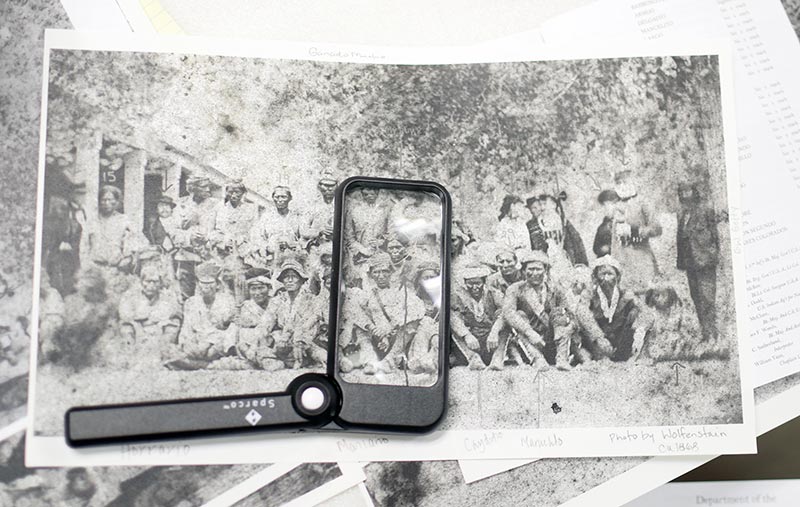
50 Years Ago: Long Walk twins attend celebration

Navajo Times | Donovan Quintero A photo taken by Swedish photographer Valentine Wolfentstein, believe to have been taken during the negotiation of the Treaty of 1868, shows Navajo leaders and military personnel at the Bosque Redondo reservation in Ft. Sumner, New Mexico.
It’s less than four months now before the Navajo Tribe holds the major 100th celebration of the signing of the Treaty of 1868 and things are beginning to come in place.
The big event, of course, is the re-enactment of the Long Walk and tribal officials are hoping that the event attracts a lot of attention not only locally but nationwide.
At the center of the publicity will be two 103-year-old twin sisters, Mrs. Crooked Neck and Old Man Mud’s Wife, who are among the only people still alive who actually were held in captivity at Fort Sumner a century ago.
“One hundred years ago, when the Navajos walked back to their homes after four years of hardship, two little girls were carried by their father and mother on the Long Walk – pretty little twin girls,” said the Navajo Times.
Today, referring to June 1968, they live in Dennehotso, said the paper, and are married and have grandchildren, great-grandchildren and great-great grandchildren.
The sisters were in good health, said Martin Link, former director of the Navajo Tribal Museum and one of the coordinators of the centennial activities that year.
While the twins were still active, one continues to herd sheep, they did not go on the long walk re-enactment but were honored as grand marshals at the centennial parade that was held.
One of the ironic bits of information as a result of the twins being involved in the celebration was the fact that one of them may not have been alive if it weren’t for them being at Fort Sumner when they were born, said Link.
Traditionally, twins were frowned upon within Navajo society a hundred years ago and often the weakest of the twins would be allowed to die after birth, said Link.
The fact is that they were delivered by medical personnel assigned to take care of the Navajos and were both allowed to survive, Link added.
The 1968 version of the Long Walk took about six days, Link said, and most people only walked a portion of the way.
The Navajo Tribal Council appropriated $180,000 for the entire celebration, which would be about $720,000 in 2018 dollars.
The Long Walk re-enactment was expected to cost between $30,000 and $35,000. The rest was to be used for other aspects of the celebration, including the printing of “A Century of Progress,” a history of the Navajo people written by Link.
One of the big topics of conversation this week on the reservation was the latest attempt to get liquor legalized on the Navajo Reservation.
“There have been many arguments, both pro and con,” said the Navajo Times.
“Many oppose legalization because of their religious convictions and/or simply because they have a distasteful attitude toward the entire question,” said Navajo Vice Chairman Nelson Damon.
“On the other hand, many would like to legalize liquor because it will increase tourism and bring more business to the reservation and money to the tribal treasury,” Damon added.
Others support the idea, Damon said, because they hope that this will teach Navajos to drink properly – if there is such a thing.
And others say that legalizing liquor will greatly reduce the number of accidents between the reservation and border towns “because it would only allow the Navajo to take his bottle into his hogan where he could take more time to drink it compared to the way it would be drunk at a bar or saloon,” Damon added.
As for his own belief, Damon said he opposed legalization.
Since drinking liquor on the reservation is prohibited, Damon said it becomes a moral question.
“One cannot put a price on moral or human value,” he said.
No amount of money from tourism could justify the “corrupting and destroying the human soul and mind,” he said.
But he said he would not be opposed to having a referendum to allow the Navajo people to decide the question.
This issue has been brought up at least twice before over the past two decades and, according to tribal officials, it never got to the point where the Navajo people had a chance to vote.
One reason is that whenever it was brought up, liquor dealers in the border communities would use massive amounts of money to support efforts opposing the referendum.
The 1968 debate ended as did the others with a lot of talk but no action.
To read the full article, pick up your copy of the Navajo Times at your nearest newsstand Thursday mornings!
Are you a digital subscriber? Read the most recent three weeks of stories by logging in to your online account.








 Highway 264,
Highway 264, I-40, WB @ Winslow
I-40, WB @ Winslow